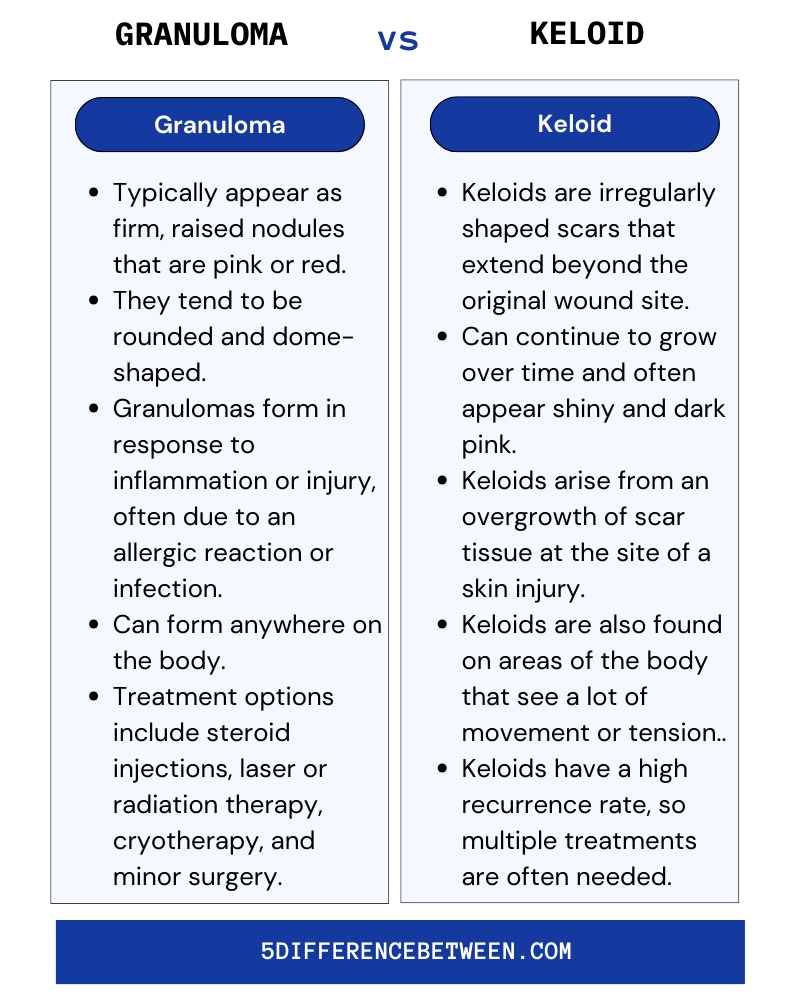The key difference between granuloma keloid is that a granuloma is a small area of inflammation filled with immune cells like macrophage whereas a keloid is an overgrowth of scar tissue that rises abruptly above the skin.
What is Granuloma?
A granuloma is a small area of inflammation filled with immune cells like macrophages. It forms around foreign objects that the body perceives as irritants. The most common causes are infections, allergic reactions, and injuries.
Granulomas typically develop slowly and last for a long time. They often form nodules under the skin that are usually painless. The nodules can vary in size and number, ranging from a few millimetres to several centimetres wide.
Also Read > Difference Between Raster Scan and Random Scan
The good news is most granulomas are benign and not a cause for concern. However, some can be a symptom of an underlying condition like tuberculosis, leprosy or a fungal infection. See your doctor for an accurate diagnosis and to determine if any treatment is needed. They may take a biopsy to examine the cells and check for signs of other disorders.
With proper care and management, many granulomas often clear up on their own over time. But for chronic or bothersome granulomas, medical procedures like steroid injections, antibiotics or surgical removal may help eliminate the inflammation and promote healing.
What is Keloid?
A keloid is an overgrowth of scar tissue that rises abruptly above the skin. Unlike regular scars that fade over time, keloids continue to grow and thicken. They often form after an injury to the skin, such as a cut, burn, or acne.
Keloids develop when your body produces too much collagen during the healing process of a wound. Collagen is a protein in the skin that provides strength and flexibility. For some reason, certain people are prone to making excess collagen which then builds up into keloids. Genetics play a role, as keloids tend to run in families. People with darker skin are also more susceptible to it.
The good news is keloids are not dangerous and they are not contagious. However, they can be disfiguring and irritating. Keloids may feel tight, itchy, and even painful. They often don’t disappear on their own and require treatment to reduce their size and symptoms.
Corticosteroids are injected directly into the keloid to reduce inflammation and slow down collagen production. Multiple injections are usually needed. Excision removes the entire keloid. It has a high recurrence rate unless also treated with steroids or radiation.
Uses targeted light pulses to break down keloid tissue. It requires multiple treatments and may not eliminate the keloid completely. High-energy radiation is directed at the keloid to shrink the tissue. It is often used after excision surgery to prevent regrowth.
The approach depends on the size, location and severity of your keloids. A combination of treatments tends to yield the best results. The key is to start treatment as early as possible before the keloids become too large. With patience and persistence, you can significantly improve the appearance of keloids.
Granuloma Vs Keloid

The key takeaway is that while granulomas and keloids share some similarities in appearance, location and treatment, they arise from different underlying causes. Recognizing these distinctions can help in developing an effective treatment plan.





